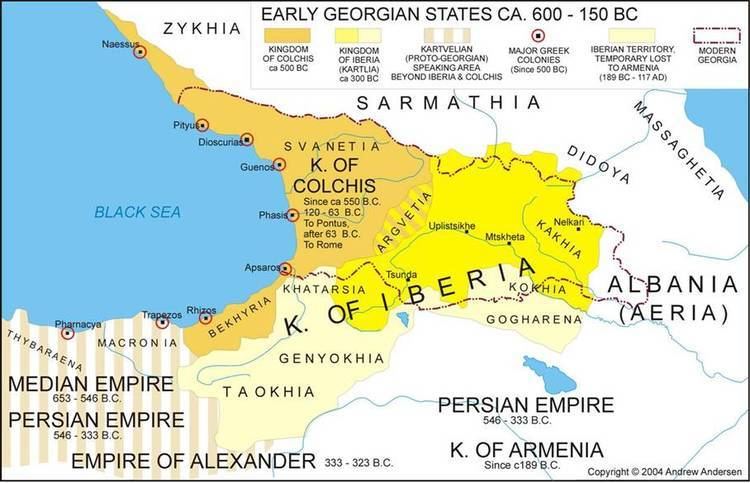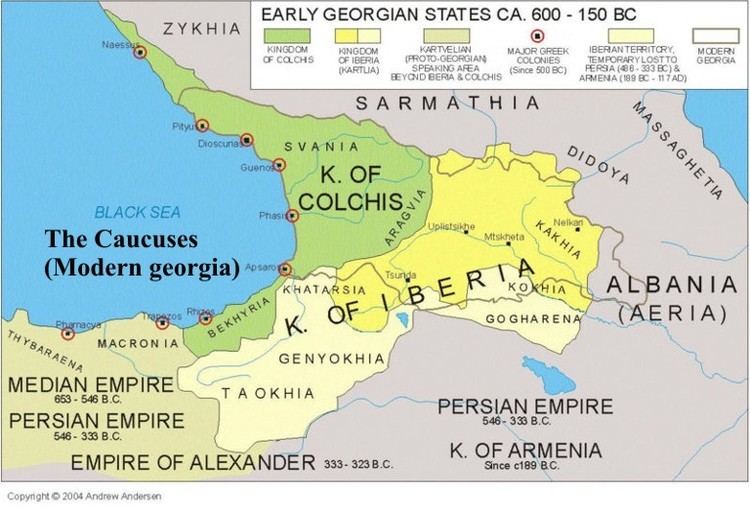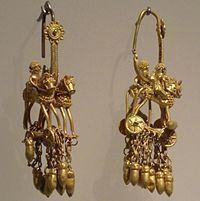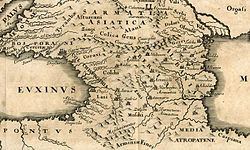Languages Kartvelian languages Historical era Iron age Disestablished 164 BC Date dissolved 164 BC | Government Monarchy Established c. 13th century BC Capital Aeaea Political structure Monarchy | |
 | ||
Ancient georgian kingdom of colchis documentary film p 1
Colchis (/ˈkɒlkɪs/; Georgian: კოლხეთი Kolkheti; Greek Κολχίς Kolkhis) was an ancient kingdom and region on the coast of the Black Sea, centered in present-day western Georgia. It has been described in modern scholarship as "the earliest Georgian formation" which, along with the Kingdom of Iberia, would later contribute significantly to the development of the medieval Georgian statehood and the Georgian nation. Internationally, Colchis is perhaps best known for its role in Greek mythology, most notably as the destination of the Argonauts, as well as the home to Medea and the Golden fleece.
Contents
- Ancient georgian kingdom of colchis documentary film p 1
- Heir s faction focus colchis total war rome 2
- Geography and toponyms
- Physical geographic characteristics
- Prehistory and earliest references
- Colchis and Persian rule
- Greek colonization
- Under Pontus
- Under Roman rule
- Rulers
- Colchis in mythology
- In popular culture
- References

Colchis was populated by Colchians, an early Kartvelian-speaking tribe, ancestral to the contemporary Western Georgians, namely Svans and Mingrelians, as well as the related Lazs. Its geography is mostly assigned to what is now the western part of Georgia and encompasses the present-day Georgian provinces of Samegrelo, Imereti, Guria, Adjara, Abkhazeti, Svaneti, Racha; modern Russia’s Sochi and Tuapse districts; and present-day Turkey’s Rize, Trabzon and Artvin provinces.

Heir s faction focus colchis total war rome 2
Geography and toponyms

The kingdom of Colchis, Kolkhis or Qulha which existed from the c. 13th to the 1st centuries BC is regarded as an early ethnically Georgian polity; the name of the Colchians was used as the collective term for early Kartvelian tribes which populated the eastern coast of the Black Sea in Greco-Roman ethnography.
According to the scholar of Caucasian studies Cyril Toumanoff:

Colchis appears as the first Caucasian State to have achieved the coalescence of the newcomer. Colchis can be justly regarded as not a proto-Georgian, but a Georgian (West Georgian) kingdom. . . .It would seem natural to seek the beginnings of Georgian social history in Colchis, the earliest Georgian formation.

A second South Caucasian tribal union emerged in the 13th century BC on the Black Sea coast. According to most classic authors, a district which was bounded on the southwest by Pontus, on the west by the Black Sea as far as the river Corax (probably the present day Bzyb River, Abkhazia, Georgia), on the north by the chain of the Greater Caucasus, which lay between it and Asiatic Sarmatia, on the east by Iberia and Montes Moschici (now the Lesser Caucasus), and on the south by Armenia. There is some little difference in authors as to the extent of the country westward: thus Strabo makes Colchis begin at Trabzon, while Ptolemy, on the other hand, extends Pontus to the Rioni River.
The name of Colchis first appears in Aeschylus and Pindar. The earlier writers only speak about it under the name of Aea (Aia), the residence of the mythical king Aeëtes: "Kolchian Aia lies at the furthest limits of sea and earth," wrote Apollonius of Rhodes. The main river was the Phasis (now Rioni), which was according to some writers the south boundary of Colchis, but more probably flowed through the middle of that country from the Caucasus west by south to the Euxine, and the Anticites or Atticitus (now Kuban). Arrian mentions many others by name, but they would seem to have been little more than mountain torrents: the most important of them were Charieis, Chobus or Cobus, Singames, Tarsuras, Hippus, Astelephus, Chrysorrhoas, several of which are also noticed by Ptolemy and Pliny. The chief towns were Dioscurias or Dioscuris (under the Romans called Sebastopolis, now Sukhumi) on the seaboard of the Euxine, Sarapana (now Shorapani), Phasis (now Poti), Pityus (now Pitsunda), Apsaros (now Gonio), Surium (now Vani), Archaeopolis (now Nokalakevi), Macheiresis, and Cyta or Cutatisium or Aia (now Kutaisi), the traditional birthplace of Medea. Scylax mentions also Mala or Male, which he, in contradiction to other writers, makes the birthplace of Medea.
Physical-geographic characteristics
In physical geography, Colchis is usually defined as the area east of the Black Sea Coast, restricted from the north by south-western slopes of the Greater Caucasus Mountain Range, from the south by the northern slopes of the Lesser Caucasus in Georgia and Eastern Black Sea (Karadeniz) Mountains in Turkey, and from the east by Likhi Range, connecting the Greater and the Lesser Caucasus Mountain Ranges. The central part of the region is Colchis Plain, stretching between Sokhumi and Kobuleti; most of that lies on the elevation below 20 m above sea level. Marginal parts of the region are mountains of the Great and the Lesser Caucasus and Likhi Range.
Its territory mostly corresponds to what is now the western part of Georgia and encompasses the present-day Georgian provinces of Samegrelo, Imereti, Guria, Adjara, Abkhazeti, Svaneti, Racha; the modern Turkey’s Rize, Trabzon and Artvin provinces (Lazistan, Tao-Klarjeti); and the modern Russia’s Sochi and Tuapse districts.
The climate is mild humid; near Batumi, annual rainfall level reaches 4,000 mm, which is the absolute maximum for the continental western Eurasia. The dominating natural landscapes of Colchis are temperate rainforests, yet degraded in the plain part of the region; wetlands (along the coastal parts of Colchis Plain); subalpine and alpine meadows.
The Colchis has a high proportion of Tertiary relict plants and animals, with the closest relatives in distant parts of the world: five species of Rhododendrons and other evergreen shrubs, wingnuts, Caucasian salamander, Caucasian Parsley Frog, eight endemic species of lizards from the genus Darevskia, Caucasian adder, Robert's vole, and endemic cave shrimps.
Prehistory and earliest references
The eastern Black Sea region in antiquity was home to the well-developed Bronze Age culture known as the Colchian culture, related to the neighboring Koban culture, that emerged towards the Middle Bronze Age. In at least some parts of Colchis, the process of urbanization seems to have been well advanced by the end of the 2nd millennium BC, centuries before Greek settlement. The Colchian Late Bronze Age (15th to 8th century BC) saw the development of significant skill in the smelting and casting of metals. Sophisticated farming implements were made, and fertile, well-watered lowlands and a mild climate promoted the growth of progressive agricultural techniques.
Colchis was inhabited by a number of related but distinct tribes whose settlements lay along the shore of the Black Sea. Chief among those were the Machelones, Heniochi, Zydretae, Lazi, Chalybes, Tabal/Tibareni/Tubal, Mossynoeci, Macrones, Moschi, Marres, Apsilae, Abasci, Sanigae, Coraxi, Coli, Melanchlaeni, Geloni and Soani (Suani). These Colchian tribes differed so completely in language and appearance from the surrounding Indo-European nations that the ancients provided various wild theories to account for the phenomenon.
Herodotus regarded the Colchians as Ancient Egyptian race.
Herodotus states that the Colchians, with the Ancient Egyptians and the Ethiopians, were the first to practice circumcision, a custom which he claims (without historical proof) that the Colchians inherited from remnants of the army of Pharaoh Sesostris. Apollonius of Rhodes states that the Egyptians of Colchis preserved as heirlooms a number of wooden tablets, which show, with considerable accuracy, seas and highways.
According to Pliny the Elder:
The Colchians were governed by their own kings in the earliest ages, that Sesostris king of Egypt was overcome in Scythia, and put to fight, by the king of Colchis, which if true, that the Colchians not only had kings in those times, but were a very powerful people.
Many modern theories suggest that the ancestors of the Laz-Mingrelians constituted the dominant ethnic and cultural presence in the region in antiquity, and hence played a significant role in the ethnogenesis of the modern Georgians.
Colchis and Persian rule
In the 13th century BC, the Kingdom of Colchis was formed as a result of the increasing consolidation of the tribes inhabiting the region. This power, celebrated in Greek mythology as the destination of the Argonauts, the home of Medea and the special domain of sorcery, was known to Urartians as Qulha (aka Kolkha, or Kilkhi). The kingdom of Tabal was conquered by the Assyrian emperor Shalmaneser III in the 830's BC. Being in permanent wars with the neighbouring nations, the Colchians managed to absorb part of Diauehi in the 750s BC, but lost several provinces (including the “royal city” of Ildemusa) to the Sarduri II of Urartu following the wars of 750-748 and 744-742 BC. Overrun by the Cimmerians and Scythians in the 730s-720s BC, the kingdom disintegrated and came under the Achaemenid Persian Empire towards the mid-6th century BC. The tribes living in the southern Colchis (Tibareni, Mossynoeci, Macrones, Moschi, and Marres) were incorporated into the 19th Satrapy of Persia, while the northern tribes submitted “voluntarily” and had to send to the Persian court 100 girls and 100 boys every five years. The influence exerted on Colchis by the vast Achaemenid Empire with its thriving commerce and wide economic and commercial ties with other regions accelerated the socio-economic development of the Colchian land. Subsequently the Colchis people appear to have overthrown the Persian Authority, and to have formed an independent state. According to Ronald Suny: This western Georgian state was federated to Kartli-Iberia, and its kings ruled through skeptukhi (royal governors) who received a staff from the king.
Greek colonization
The advanced economy and favorable geographic and natural conditions of the area attracted the Milesian Greeks who colonized the Colchian coast establishing here their trading posts at Phasis, Gyenos, and Sukhumi in the 6th-5th centuries BC. It was considered "the farthest voyage" according to an ancient Greek proverbial expression, the easternmost location in that society's known world, where the sun rose. It was situated just outside the lands conquered by Alexander the Great. Phasis and Dioscurias were the splendid Greek cities dominated by the mercantile oligarchies, sometimes being troubled by the Colchians from the hinterland before seemingly assimilating totally. After the fall of the Persian Empire, a significant part of Colchis locally known as Egrisi was annexed to the recently created Kingdom of Iberia (Kartli) in ca. 302 BC. However, soon Colchis seceded and broke up into several small princedoms ruled by sceptuchi. They retained a degree of independence until conquered (circa 101 BC) by Mithridates VI of Pontus.
Under Pontus
Mithradates VI quelled an uprising in the region in 83 BC and gave Colchis to his son Mithridates, who was soon executed being suspected in having plotted against his father. During the Third Mithridatic War, Mithridates VI made another of his sons, Machares, king of Colchis, who held his power but for a short period. On the defeat of Mithridates VI of Pontus in 65 BC, Colchis was occupied by Pompey, who captured one of the local chiefs (sceptuchus) Olthaces, and installed Aristarchus as a dynast (65–47 BC). On the fall of Pompey, Pharnaces II, son of Mithridates, took advantage of Julius Caesar being occupied in Egypt, and reduced Colchis, Armenia, and some part of Cappadocia, defeating Gnaeus Domitius Calvinus, whom Caesar subsequently sent against him. His triumph was, however, short-lived. Under Polemon I, the son and heir of Zenon, Colchis was part of the Pontus and the Bosporan Kingdom. After the death of Polemon (8 BC), his second wife Pythodorida of Pontus retained possession of Colchis as well as of Pontus itself, though the kingdom of Bosporus was wrested from her power. Her son and successor Polemon II of Pontus was induced by Emperor Nero to abdicate the throne, and both Pontus and Colchis were incorporated in the Province of Galatia (63) and later in Cappadocia (81). Phasis, Dioscurias and other Greek settlements of the coast did not fully recover after the wars of 60-40 BC and Trebizond became the economical and political centre of the region.
Under Roman rule
Despite the fact that all major fortresses along the seacoast were occupied by the Romans, their rule was relatively loose. In 69, the people of Pontus and Colchis under Anicetus staged a major uprising against the Romans which ended unsuccessfully. The lowlands and coastal area were frequently raided by fierce mountain tribes, with the Soanes and Heniochi being the most powerful of them. Paying a nominal homage to Rome, they created their own kingdoms and enjoyed significant independence. Christianity began to spread in the early 1st century. Traditional accounts relate the event with Saint Andrew, Saint Simon the Zealot, and Saint Matata. The Hellenistic, local pagan and Mithraic religious beliefs would however remain widespread until the 4th century. By the 130s, the kingdoms of Machelones, Heniochi, Egrisi, Apsilia, Abasgia, and Sanigia had occupied the district from south to north. Goths, dwelling in the Crimea and looking for new homes, raided Colchis in 253, but were repulsed with the help of the Roman garrison of Pitsunda. By the 3rd-4th centuries, most of the local kingdoms and principalities had been subjugated by the Lazic kings, and thereafter the country was generally referred to as Lazica (Egrisi).
Rulers
Little is known of the rulers of Colchis;
Note: During his reign, the local chiefs, sceptuchi, continued to exercise some power. One of them, Olthaces, is mentioned by the Roman sources as a captive of Pompey in 65 BC.
Colchis in mythology
In Greek mythology, Colchis was the home of Aeëtes, Medea, the Golden Fleece, fire-breathing bulls Khalkotauroi and the destination of the Argonauts.
Colchis is also thought to be the possible homeland of the Amazons.
According to the Greek mythology, Colchis was a fabulously wealthy land situated on the mysterious periphery of the heroic world. Here in the sacred grove of the war god Ares, King Aeëtes hung the Golden Fleece until it was seized by Jason and the Argonauts. Colchis was also the land where the mythological Prometheus was punished by being chained to a mountain while an eagle ate at his liver for revealing to humanity the secret of fire. Amazons also were said to be of Scythian origin from Colchis.
Apollonius of Rhodes named Aea as the main city (Argonautica, passim). The main mythical characters from Colchis are:
In popular culture
Historical Colchis and its relation to Greek mythology has influenced popular culture whith the result of several movies and miniseries as well as fictional depictions.
